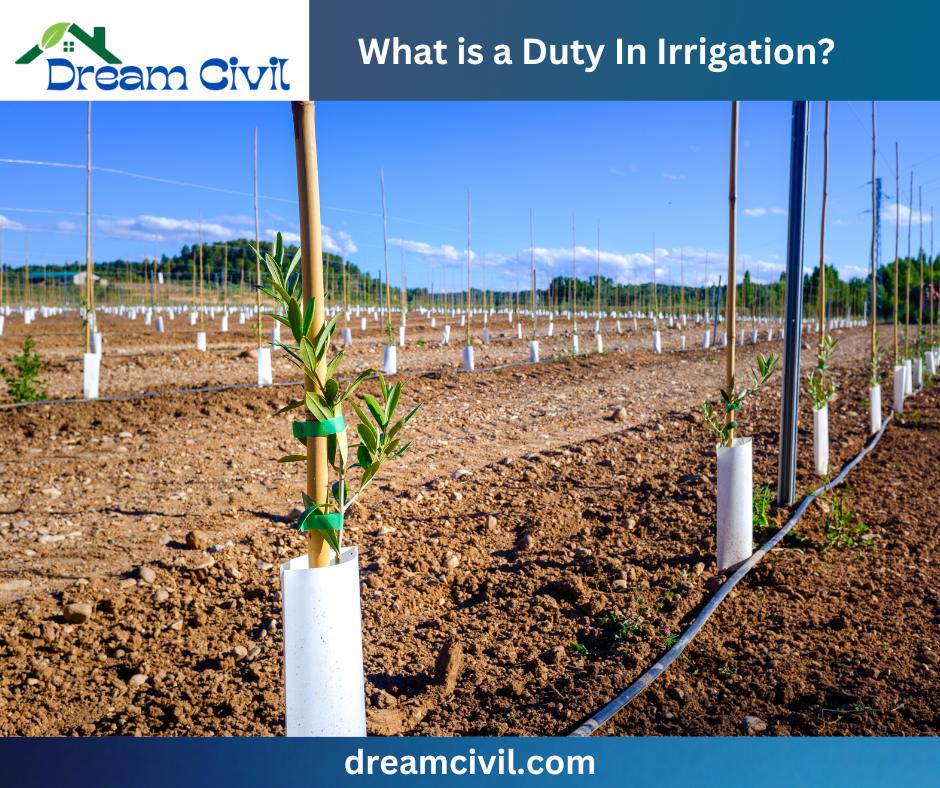Table of Contents
1. What is a Duty In Irrigation?
✓ The Duty of water is the relationship between the water volume and the land area it matures.
Duty is defined as the area of land (in hectares) that can be irrigated with a continuous supply of 1 m³/sec of water during a crop’s entire growing period ( base period ).
✓ Duty of water is generally expressed in hectares per cubic meter (hectare/cumec) and is denoted by the letter D.

✔ Mathematically,
D=A/Q
Where,
D=Duty in hectares/cumec
A=Area in hectares
Q=Discharge in m³/s
✔ Duty can also be expressed as
D=8.44 B/Δ
Where;
B = Base period of crop
Δ = Delta of crop
2. What are the Types of Duty In Irrigation?
Duty can be classified as:
a. Flow duty
✔ In direct irrigation, water from the source is directly supplied to the irrigating field without storing it. Hence, the Duty of water in direct irrigation is called flow duty.
✔ It is expressed in hectare/cumec.
b. Quantity duty or Storage duty
✔ In storage irrigation, water from the source is supplied to the reservoir or storage unit, and then the required amount of water is supplied to the irrigation field from the storage unit. Hence, the Duty of water in storage irrigation is Quantity Duty / Storage Duty.
✔ Quantity duty is expressed in hectares per million cubic meters of water available in a reservoir. This means that a certain number of hectares of a particular crop can be irrigated with every million cubic meters of water available in the reservoir.
✔ The irrigating capacity of the reservoir is directly known, which helps to determine the Duty.
3. What are the Factors Affecting Duty In Irrigation?
Duty in irrigation depends upon the following subsequent factors:

1. Type of crop
✓ The water demand for numerous crops is entirely different. So, the Duty varies from crop to crop.
✓ The Duty is less for a crop requiring high water and vice versa.
2. Climate & Season
✓ The Duty varies from season to season and from time to time in the same season. The Duty also includes the water lost in evaporation and percolation.
✓ Losses due to evaporation and percolation vary with climatic conditions. The values of duties generally expressed are their average values considered in the entire crop period.
✓ Duty in the winter season & rainy season is more and less in the summer.
3. Rainfall
✓ More rainfall leads to less requirement for irrigation water.
✓ This means that if rain falls during the crop period, Duty will increase and vice versa.
4. Soil type
✓ The Duty in irrigation will be less for porous soil and vice versa.
✓ In coarse-grained soil, percolation is high, so Duty is low.
✓ In fined-grained soil, percolation is less, so Duty is high.
✓ The Duty of clayey soil is more than that of sandy soil.
5. Method of Ploughing
✓ Proper Ploughing of the land reduces the number of watering & increases Duty. But for faulty cultivation & improper Ploughing, Duty is decreased.
6. Method of irrigation
✓ The Duty of water is high in the case of the perennial irrigation system as compared to the inundation irrigation system.
7. The topography of agricultural land
✓ If the agricultural land is uneven, the water requirement will be higher; hence, Duty will be low and vice versa.
✓ As the ground slope increases, the Duty decreases due to water wastage.
8. Base period
If the base period is extended, the water requirement will be higher, the Duty will be low, and vice versa.
9. Skill of cultivation
✓ A skilled & properly trained cultivator can make judicious use of water; therefore, Duty will be high.
4. What is the Importance of Duty in Irrigation?
✓ The knowledge of Duty helps engineers design efficient canal irrigation systems.
✓ Knowing the Duty of different crops and their areas helps estimate the discharge required for designing the irrigation canal.
5. What are the Methods For Improving Duty?
1. Ploughing the land to the proper depth increases the moisture-retaining capacity of the soil. Hence, Duty gets improved.
2. Reduction in percolation loss. The canal should be lined to reduce percolation losses.
3. Land used for cultivation should be leveled as far as possible.
4. To increase the soil’s water-holding capacity, manure fertilizers should be added.
5. Rotation of crops will ensure increased crop yield with minimum water use.
6. Method of irrigation should be efficient.
7. The cultivators should be trained & skillful.
8. The land should be regularly cultivated.
9. Reduction of transmission losses. The canal should be close to the irrigable land to minimize transmission losses.
6. What is the Relationship of Duty with Delta and Base Period?
✓ Let us consider a crop having a base period of B days. Assume that one cumec of water is supplied to this crop for B days to provide Delta Δ m water depth.
✓ Now, the volume of water supplied by unit discharge to this crop during B days is given by:
V=Q (m³/s)*B (days)
V= 1*24*60*60*B m³ { B days = 24*60*60 Seconds & Q = 1 m³/s }
V=8.64*10000 B m³ …(1)
✓ The volume of water applied to the field can also be calculated as:
V=Area of land irrigated by unit discharge * depth of water applied
V=D(ha)*Δ (m)
V=D *Δ*10000(m³) ….(2)
✓ From Eqn 1 & 2 , we get
8.64*10000*B= D*Δ*10000
D=(8.64*B)/Δ
7. Duty – Numerical Example
a. Calculate Duty based on the following data:
Base peroid=110 days
Duty(D)=?
Delta(Δ)=68cm = 0.68m
solution,
From delta duty relationship;
D=8.64*B/Δ
D= 8.64* 110/0.68
∴ D = 1398 ha/cumec
| Read More: Flooding Irrigation |
| Verified Article By Er. Madhu Krishna Poudel |

